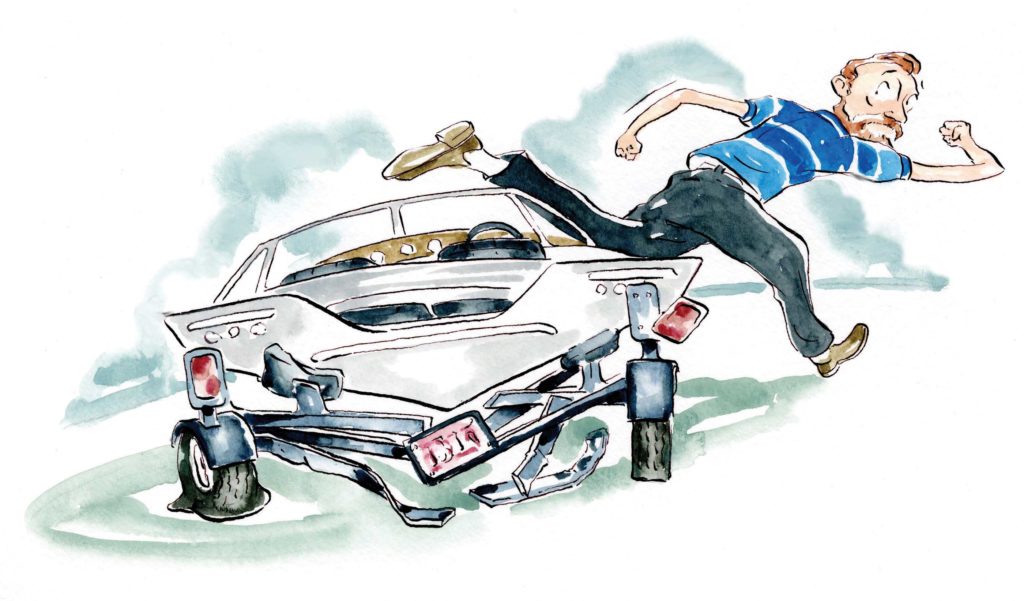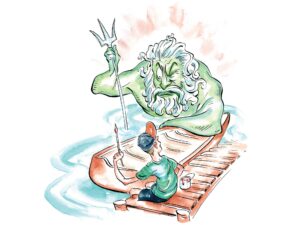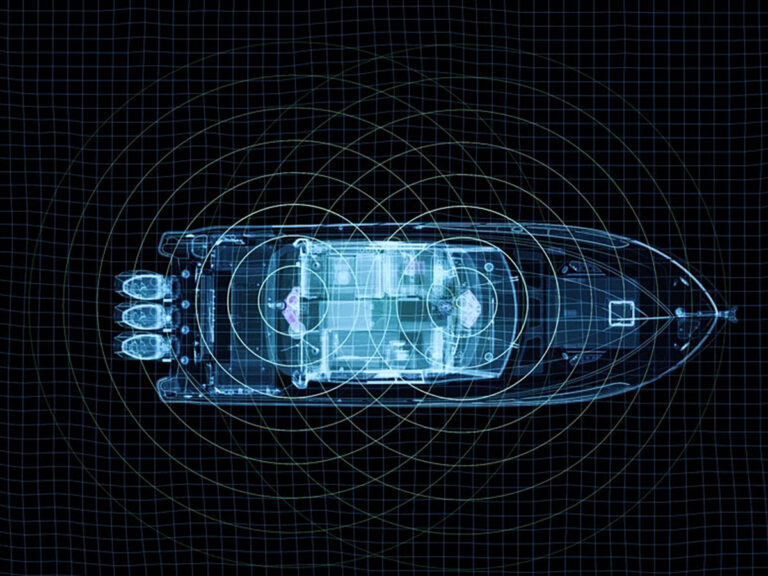
Getting your boat ready for another season of use is one of the joys of ownership. Seriously, it is—as long as you think of it positively. It’s not the end of another season; it’s the beginning of a new one. The possibilities for new boating adventures seem endless, and making sure your boat is ready for all the fun is a great responsibility. Even if you’re religious about winterizing, there’s still lots to be done to ensure trouble-free outings—not to mention taking advantage of potential upgrades. On the other side, if your winterizing regimen leaves a lot to be desired, now’s the time to correct all of last fall’s mistakes.
It’s easier to tackle the project if you divvy it up by systems—steering, fuel, engine, drive, cooling, etc. It’ll go faster this way, and there’s less chance to forget something important. There’s also cleaning and polishing to finish off after the systems’ checkups are complete. Ready to start? Here we go.
Uncover It
For those who have covered up the boat over the winter months:
- Check for bees’ nests and other potential dangers (skunks, snakes, cats, etc.) before pulling off the cover. Even though your visual inspection may not have revealed critters, take a second look for bees’ or wasps’ nests—sometimes they build almost undetectable nests in near-impossible locations. These will cause problems on the water; for example, they can affect the overboard telltale water indicator on an outboard, the water intakes, or the fuel-tank vent outlet. If you find any of these mud dauber nests, clear them out completely before going boating.
- Before the cleanup commences, it’s best to go through the rig and engine, looking for problems. Check for the obvious—broken windshield frames, moldy seats and carpet, rusted fittings, rodent droppings, and snow and wind damage are just a few things you might find. Make a list of what needs attention, and tackle the problems one at a time.
- If you must dispose of a temporary winter cover (shrink-wrap), please do so responsibly. (Note: Careful removal can enable the reuse of shrink-wrap, if you have a place to store it.)

Fuel-System Finds
The engine can’t run if it can’t get fuel. Fuel-system inspection and maintenance has never been more important thanks to the havoc that ethanol-blended gasoline can wreak on fuel lines, filters and components.
- If the fuel lines are older than three years, they should be replaced with new EPA-compliant, Coast Guard-approved hose and new clamps. The innards of older fuel hoses are highly susceptible to alcohol deterioration; if left unchecked, this can cause clogging, poor running and even engine failure.
- Check the primer bulb, if your rig has one; these can be damaged by ethanol blends too.
- The fuel filter should be replaced as well. If your rig doesn’t have a water-separating fuel filter, now is a good time to add one.
- Finally, check the tank carefully for leaks, cracks and loose mounts.
Charge It: Batteries and Electrical Systems
The batteries should be charged and checked to ensure they’ll hold a charge.
- The terminals and cable ends should be cleaned and checked for tightness.
- A visual once-over to ensure the batteries are secured and can’t tip over is good practice.
- Lights, horn, gauges, wiper, trim tabs and all other accessories should be checked for proper operation and repaired if necessary. Over time, and especially in saltwater environments, the wiring and switches can become corroded and fail.

Engine Hours
Whatever your power choice (outboards, two-stroke or four-stroke, sterndrives, inboards, personal watercraft, etc.), it must be checked over carefully before the first outing of the season.
- Inboards and sterndrives: Block water plugs (aka freeze plugs) must be replaced in their proper locations before running the engine. Belts and hoses should be checked for tightness and cracks. If it wasn’t changed in the fall, the engine oil and filter should be changed now. (Don’t forget to change it next fall.)
- All engines should be connected to a water source (preferably in the water, but if that’s not possible, at least with a flush muff or similar device), started, and allowed to run long enough to reach operating temperature while running at idle.
- Check for proper cooling (the telltale or water out the exhaust) and water leaks.
- All fittings (tilt tube, swivel bracket, hood latches, etc.) should be greased.
- The gear case should be checked for damage, along with the propeller and propeller shaft. If it wasn’t done in the fall, the gear-case lube should be drained, checked for contamination (milky equals water ingestion and seal failure; dark and stinky equals potential gear and bearing damage), and refilled with fresh lubricant. The skeg should be checked and repaired if bent or damaged. Check water intakes for blockage.
- Any corrosion should be sanded down, prepped and repainted. Sacrificial anodes should be checked and replaced if they’re significantly eroded.
- The entire engine should be given a coat of wax to protect it from the water and sun.
- Engine wiring and the electrical system should be checked and cleaned, especially if corroded.
Steering & Controls
Steering and shift-and-throttle controls are critical to driving the boat. But also think about this: Not checking and maintaining them could make you liable in an accident. Therefore, they should be your first priority.
- For cable steering systems, ensure they work smoothly, operate properly, and are lubricated with marine-grade grease.
- Hydraulic steering systems should be properly bled to purge any air bubbles, and checked to ensure they work properly. No skips, binding or excess steering-wheel movement can be allowed.
- The engine steering arm, steering link, and fastening bolts and nuts must be checked for integrity, corrosion and tightness.
- The shift and throttle should be checked with the engine running on a flusher, or while in the water tied to the dock. Make sure the engine shifts into forward and reverse from neutral and back again with no binding or excessive movement of the shifter lever, and the propeller stops rotating when the engine is shifted to neutral.

All Systems Go?
It’s not always just about the boat and the onboard equipment. Getting ready for the season ahead also involves inspection of items that you carry on the boat, including watersports equipment and safety gear, as well as paperwork.
- Check all systems, including plumbing, coolers, bait and fish wells, the shower and head, and galley components. Check carefully for loose or cracked hoses and fittings, especially through-hull fittings and drains.
- Check all accessories and toys, such as skis, tubes, vests, towropes, etc.
- Check all safety items—life jackets, lines, anchors, flags, emergency systems, first-aid kits, flares, etc. Now is also a good time to request a vessel safety check from the US Coast Guard Auxiliary or Power Squadrons.
- Certainly not least: Check to make sure you have the current license, registration, permits and insurance, not to mention towing insurance from a service such as TowBoatUS or Sea Tow.
Trailer Troubles
If you’re a trailer boater, you must do a complete trailer check. You’ve seen one of those stranded boaters along the roadside, waiting for a flatbed—don’t be that guy. Here’s where to check:
- Frame: Check for integrity, excessive corrosion (rust-through) and overall appearance.
- Running gear (axle, springs, attachments, bearings and seals, wheels and tires): Check all and replace any suspect items. Check axle and springs carefully for corrosion, sagging or rust-through. Look at the wear pattern on the tires; this gives a good indication of axle and spring condition. Check to ensure fenders are not loose, rusted through, or ready to come off during travel.
- Hull support (bunks, rollers, guides, stanchions): Check for rot, worn carpet, broken bolts, etc. Hull damage can easily occur while towing due to bunk or roller problems that went undetected.
- Check the winch, stand, winch strap and cable, tie downs and emergency chain. All of these secure your boat to the trailer during transport and are vital safety items.
- The coupler, tongue and safety chains are also critical safety items because they connect your rig to the tow vehicle. Check them carefully and replace any suspect parts.
- Lights and wiring: Ensure all functions work, and repair or replace any lights (or even the entire wiring harness) if necessary. Lights and wiring harnesses are inexpensive and easy to service.
- License, registration and insurance: Again, last but certainly not least, verify these are up to date. You don’t want a ticket for any reason on your trip to the water.

Hull Inspection
A thorough hull and deck inspection is best conducted on land before launching the boat for the season.
- Check the topsides for cracks, a loose rub rail and cleats, and a damaged windshield or frame.
- Bottom paint should be checked and reapplied if it’s showing age.
- Climb under the trailer and inspect every inch of the hull. You might be surprised at what you find. Nicks, chips and dings (especially those through the gelcoat and into the fiberglass) should be repaired before the season starts. Gelcoat blistering should be repaired.
- On aluminum hulls, check for cracks, missing and loose rivets, and broken welds.
- Check the hull’s integrity, including inspecting the hull, stringers, deck and transom for moisture.
- Examine the gelcoat and finish, and consider having the boat detailed.
Read Next: Our online guide to everything your need for fitting-out your boat in Spring!
So, you made it through this entire checklist, made the necessary repairs, and your boat and trailer are ready to go. It’s time to head down to the local boat ramp and prepare to launch. Don’t forget the drain plug and the life jackets. Also, make sure you clip on the kill switch. Tie your boat up at the launch ramp dock, and fire it up while you’re still tied off. Turn on your electronics too. If all is good to go, get out on the water and enjoy. It’s why we all do this in the first place.









